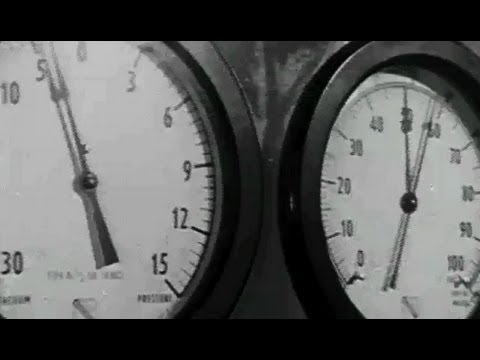more at
“ELEMENTARY SCHOOL TEACHER TAKES CLASS ON FIELD TRIP TO CITY WATERWORKS. GUIDE EXPLAINS PLANT OPERATION–STORAGE TANKS, LABORATORY WATER TESTING FOR PURITY, FILTRATION, CHEMICAL TREATMENT. PUMPS SUPPLY FIRE DEPARTMENT, STREET CLEANING, LAUNDRY.”
NEW VERSION with improved video & sound:
Public domain film from the Prelinger Archive, slightly cropped to remove uneven edges, with the aspect ratio corrected, and mild video noise reduction applied.
The soundtrack was also processed with volume normalization, noise reduction, clipping reduction, and/or equalization (the resulting sound, though not perfect, is far less noisy than the original).
Water supply is the provision of water by public utilities, commercial organizations, community endeavors or by individuals, usually via a system of pumps and pipes. Irrigation is covered separately…
Technical overview
Water supply systems get water from a variety of locations, including groundwater (aquifers), surface water (lakes and rivers), conservation and the sea through desalination. The water is then, in most cases, purified, disinfected through chlorination and sometimes fluoridated. Treated water then either flows by gravity or is pumped to reservoirs, which can be elevated such as water towers or on the ground (for indicators related to the efficiency of drinking water distribution see non-revenue water). Once water is used, wastewater is typically discharged in a sewer system and treated in a sewage treatment plant before being discharged into a river, lake or the sea or reused for landscaping, irrigation or industrial use.
Service quality
Many of the 3.5 billion people having access to piped water receive a poor or very poor quality of service, especially in developing countries where about 80% of the world population lives. Water supply service quality has many dimensions: continuity; water quality; pressure; and the degree of responsiveness of service providers to customer complaints.
Continuity of supply
Continuity of water supply is taken for granted in most developed countries, but is a severe problem in many developing countries, where sometimes water is only provided for a few hours every day or a few days a week. It is estimated that about half of the population of developing countries receives water on an intermittent basis.
Water quality
Drinking water quality has a micro-biological and a physico-chemical dimension. There are thousands of parameters of water quality. In public water supply systems water should, at a minimum, be disinfected—most commonly through the use of chlorination or the use of ultra violet light—or it may need to undergo treatment, especially in the case of surface water. For more details, please see the separate entries on water quality, water treatment and drinking water.
Water pressure
Water pressures vary in different locations of a distribution system. Water mains below the street may operate at higher pressures, with a pressure reducer located at each point where the water enters a building or a house. In poorly managed systems, water pressure can be so low as to result only in a trickle of water or so high that it leads to damage to plumbing fixtures and waste of water. Pressure in an urban water system is typically maintained either by a pressurized water tank serving an urban area, by pumping the water up into a tower and relying on gravity to maintain a constant pressure in the system or solely by pumps at the water treatment plant and repeater pumping stations.
Typical UK pressures are 4–5 bar for an urban supply.[citation needed] However, some people can get over eight bars or below one bar. A single iron main pipe may cross a deep valley, it will have the same nominal pressure, however each consumer will get a bit more or less because of the hydrostatic pressure (about 1 bar/10 m height). So people at the bottom of a 100-foot (30 m) hill will get about 3 bars more than those at the top…
The technique of purification of drinking water by use of compressed liquefied chlorine gas was developed in 1910 by U.S. Army Major (later Brig. Gen.) Carl Rogers Darnall (1867–1941), Professor of Chemistry at the Army Medical School. Shortly thereafter, Major (later Col.) William J. L. Lyster (1869–1947) of the Army Medical Department used a solution of calcium hypochlorite in a linen bag to treat water. For many decades, Lyster’s method remained the standard for U.S. ground forces in the field and in camps, implemented in the form of the familiar Lyster Bag (also spelled Lister Bag). Darnall’s work became the basis for present day systems of municipal water ‘purification’…

